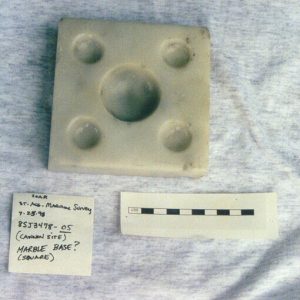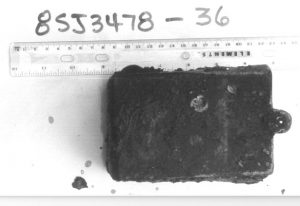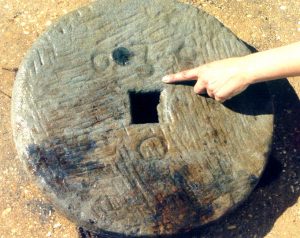CRL Reports: Site 8SJ3478 – Requests for Assistance
Requests for Help with Identification, Analysis and Information Regarding Artifacts of Comparative Provenance
The following sections detail areas where input from any interested parties would be much appreciated. Please reply to Marianne Franklin at INCSOAR@AOL.COM.
 A. Information Regarding Stylized "A" on George II (1727-1760) 6-Pound Cannon Trunnion (8SJ3478-01)
A. Information Regarding Stylized "A" on George II (1727-1760) 6-Pound Cannon Trunnion (8SJ3478-01)
Standard sources for identifying 18th-century maker's marks have been reviewed, yet no parallel for the stylized "A" on the 6-pound gun 8SJ3478-01 has been discovered. The drawing on the right shows the mark on the trunnion.
*** UPDATE : Identification of the Foundry ***
The mark on the trunnion of the cannon has been identified. Ruth Rhynas Brown ("Identifying 18th-century Trunnion Marks on British Iron Guns: A Discussion", IJNA, 1989:18:4") has provided information from additional research in the Board of Ordnance to be published by the Royal Armouries next year.
The A on the trunnion is from the Ashburnham Furnace in Sussex, Southern England. Brown states that during this time period "the furnace was run by the Crowley family, at first two brothers, Ambrose and John"; and after their deaths, "by their mother and sister, both called Theodosia. The guns of this period usually have the A on the right-handed trunnion and have a crooked bar. It was probably cast either for the war of Austrian Succession 1744-49, or the earlier period of the Seven Years' War" (Brown, personal communication, May 2000).

Square Marble Base 8SJ3478-05
The marble base (8SJ3478-05) was recovered during the 1998 field season. The base measures 12.3 cm by 12.2 cm and is 3.2 cm thick. The center circle impression measures 5 cm in diameter and is 1.6cm deep. The four adjacent circular impressions measure just under 3 cm outer diameter, and are .08 cm deep. Various suggestions for identification of the object include a base for an hourglass and a pipe stand. To date, no positive identification has been made.
Lead Box Container 8SJ3478-36
 This lead box-like object was recovered during the 1999 field season. An additional identical container was recorded in situ and not recovered. Figure 9 shows lead object 8SJ3478-36 after recovery. The container measures 8.5 cm square at its base and is 13.5 cm high. Average thickness is 0.6 cm. A hole (0.4 cm diameter), probably for a handle, is punched in each of the two "lugs" which measure 2 cm by 1.6.1 cm. Objects similar in size and identical in design have been recovered from Port Royal, Jamaica (Hamilton, personal communication 1999) and several other British shipwrecks sites (Larn, IJNA 1984:13.2:113-119). No positive identification of any of the lead containers has been found to date. An unpublished student manuscript on file at CRL shows that the containers recovered span the date range between sites from 1684 through 1778. One specimen was stamped with the reversed date of 1675.
This lead box-like object was recovered during the 1999 field season. An additional identical container was recorded in situ and not recovered. Figure 9 shows lead object 8SJ3478-36 after recovery. The container measures 8.5 cm square at its base and is 13.5 cm high. Average thickness is 0.6 cm. A hole (0.4 cm diameter), probably for a handle, is punched in each of the two "lugs" which measure 2 cm by 1.6.1 cm. Objects similar in size and identical in design have been recovered from Port Royal, Jamaica (Hamilton, personal communication 1999) and several other British shipwrecks sites (Larn, IJNA 1984:13.2:113-119). No positive identification of any of the lead containers has been found to date. An unpublished student manuscript on file at CRL shows that the containers recovered span the date range between sites from 1684 through 1778. One specimen was stamped with the reversed date of 1675.
Millstone 8SJ3478-04

At least two similar stones have been observed on site. Stone 8SJ3478-04 was first observed in 1997 and recovered in 1998. This photograph shows the millstone after cleaning. The numbers 0-3-0 are etched on one side of the stone. This denotes the weight of the stone in hundredweights: three-fourths of one hundredweight, or 84 pounds. The stone measures 20 inches (50cm) in diameter and is 3 inches thick (7 cm). The hole in the center measures 2.5 inches (6.0cm) square. A second "0" is etched beneath the center of the stone. Cross-hatch marks are etched onto the face of the stone.
Information on millstones recovered from comparative sites is requested. In addition, any ideas on the type of mechanism that would have held the stone to work the grain would be helpful. Studies of Diderot and numerous contemporaneous texts describing millwork have turned up similar stones and mechanisms, but none are exact.
Citation Information:
Franklin, Marianne
2000, Site 8SJ3478, possibly the Industry: A British 18th-Century Shipwreck, Conservation Research Laboratory Research Report #10, World Wide Web,
URL, https://liberalarts.tamu.edu/nautarch/crl-reports-site-8sj3478-requests-for-assistance/. Nautical Archaeology Program, Texas A&M University
